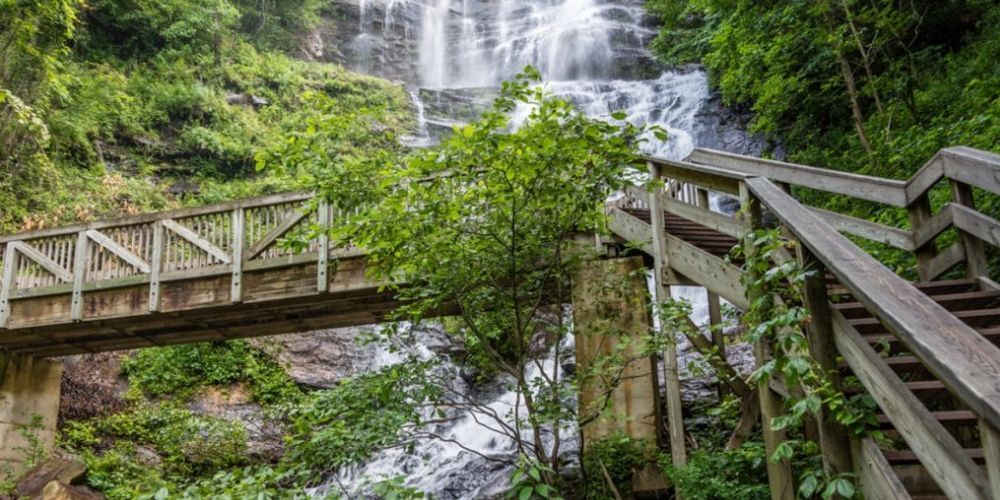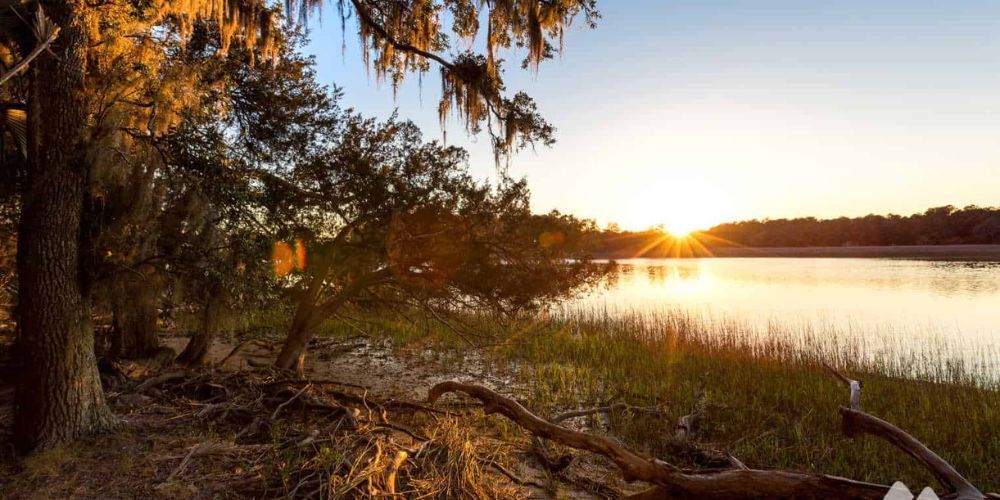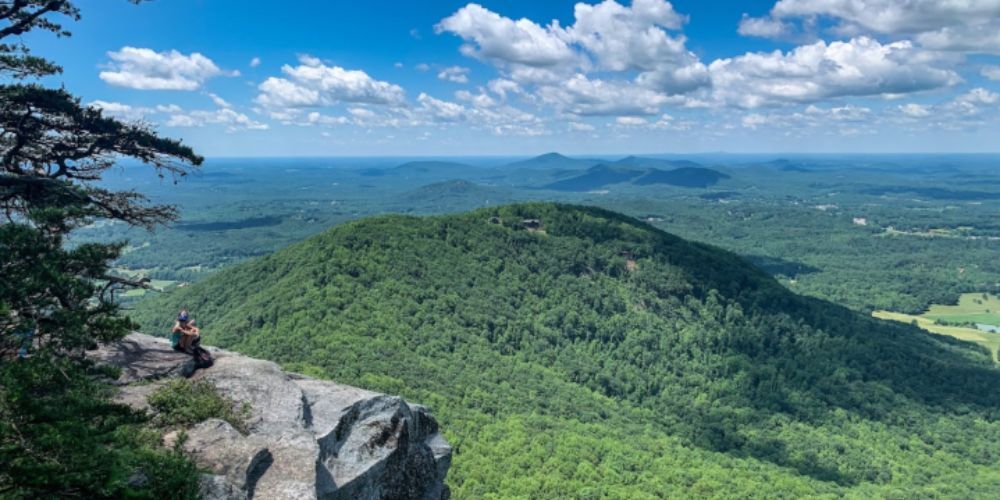Hiking in Georgia: Explore the Best Trails in the Peach State
Hiking in Georgia offers a rich tapestry of experiences, from easy strolls through verdant forests to challenging ascents rewarded with panoramic vistas. The variety of trails available reflects as much diversity in landscape as in difficulty, ensuring there's a path for every hiker’s preference and ability. For those looking to immerse themselves in nature while capturing breathtaking photos, Georgia's trails promise memorable adventures marked by cascading waterfalls, dense woodlands, and towering peaks.
However, finding precise and current information about these trails can be daunting. To address this, we have meticulously gathered data from official park sites, local hiking communities, and recent trail reviews to bring you a comprehensive guide. Whether you're looking for tranquil paths or seeking the challenge of reaching Georgia’s highest peak, this detailed overview will prepare you with essential tips on what to expect before embarking on your journey. Let's start by understanding the trail difficulty ratings and any necessary permits you'll need to explore these beautiful landscapes responsibly.
The best hiking trails in Georgia include the Appalachian Trail, Amicalola Falls State Park, and Tallulah Gorge State Park. These trails offer diverse landscapes and varying levels of difficulty, providing hikers with a range of options to explore the natural beauty of Georgia.

Essential Hiking Information
When setting out on a hike in Georgia, it's crucial to understand trail difficulty ratings. Trails throughout the state vary widely in terms of difficulty, with some being easy strolls suitable for beginners, while others present significant challenges even for experienced hikers. Familiarizing yourself with these ratings beforehand can help ensure that you select a route that aligns with your skill level and physical capabilities.
Georgia's trail difficulty ratings typically follow a standardized system, such as the one developed by the Yosemite Decimal System (YDS). This system categorizes trails from Class 1 (easiest) to Class 5 (most difficult), taking into account factors such as elevation gain, terrain ruggedness, and exposure to potential hazards. By understanding and adhering to these ratings, hikers can make well-informed decisions about which trails are appropriate for their abilities.
For instance, the Totem Falls Trail is generally classified as an easy route due to its gentle terrain and minimal elevation changes. On the other hand, sections of the Appalachian Trail in Georgia can be extremely challenging, featuring steep ascents, rocky paths, and unpredictable weather conditions.
It's also important to acquire permits if necessary before embarking on certain hikes in Georgia. Many protected areas, including state parks and national forests, may require hikers to obtain permits for entry or specific trails. It's advisable to check local guidelines or visit park websites for information regarding permit requirements, as this can vary depending on the location and time of year.
Furthermore, a well-rounded understanding of local wildlife is invaluable when hiking in Georgia. The state is home to a diverse array of flora and fauna, including black bears, deer, various snake species, and numerous bird species. Familiarizing yourself with the native wildlife not only enhances your overall hiking experience but also provides essential knowledge for safe and respectful interactions with these creatures.
Hikers should educate themselves on best practices for wildlife encounters as part of their preparation. For example, understanding how to react to black bear sightings or knowing how to safely navigate around snakes can prevent unnecessary conflicts and ensure the wellbeing of both hikers and animals.
Quick Tip: When hiking in bear country, it's recommended to carry bear spray as a precautionary measure against potential encounters. Additionally, making noise while hiking can help alert wildlife to your presence and minimize surprise encounters.
Equipped with an understanding of trail difficulty ratings, permit requirements, and insights into local wildlife, you are well-prepared to embark on a safe and fulfilling hiking adventure in Georgia.
As you lace up your hiking boots and prepare for an exhilarating outdoor escapade in Georgia, let's now journey into the heart of the Peach State's natural beauty—a collection of popular trails nestled within the Chattahoochee National Forest.
Popular Trails in Chattahoochee National Forest
The Chattahoochee National Forest is a treasure trove of stunning trails and natural beauty, attracting hikers from near and far. One of the most beloved trails in this area is the Raven Cliff Falls Trail. This moderate 5-mile round trip trail offers more than just invigorating exercise—it rewards hikers with breathtaking views of cascading waterfalls and serene forest paths, making it a must-visit for avid hikers and nature enthusiasts alike.
Another gem in Chattahoochee National Forest is the Anna Ruby Falls Trail. This easy 0.8-mile trail provides an accessible and well-maintained path, offering the chance to witness two majestic waterfalls converging into Smith Creek. Its accessibility makes it perfect for hikers of all skill levels, providing a tranquil and awe-inspiring experience without requiring extensive physical exertion.
For those seeking a challenge and an opportunity to conquer Georgia's highest peak, the Brasstown Bald Trail is an exhilarating choice. This demanding 1.2-mile trail leads to the pinnacle of Brasstown Bald, where panoramic views of four states await. As you ascend, the diverse terrain and jaw-dropping vistas create an unforgettable experience that will leave you in awe of the natural grandeur around you.
Appalachian Trail Access
Lastly, within the vast expanse of Chattahoochee National Forest, hikers have the chance to access a portion of the renowned Appalachian Trail. Stretching for 79 miles through this lush forest, this section showcases an array of landscapes and astounding viewpoints, immersing you in the beauty and tranquility of nature, providing an escape from the hustle and bustle of everyday life.
While each trail offers its own unique allure, they all share one common feature: the ability to immerse hikers in the serene majesty of nature, making every journey a rewarding adventure.
Intrigued by the enchanting trails available in Chattahoochee National Forest? Now let's shift our focus to understanding the seasonal weather patterns and trail conditions that can impact your hiking experience.
Seasonal Weather and Trail Conditions
The changing seasons present unique opportunities and challenges for hikers venturing into the Chattahoochee National Forest. Understanding the distinct characteristics of each season is vital for ensuring a safe and enjoyable hiking experience.
Spring (March-May)
As the forest bursts to life in spring, wildflowers adorn the trails, painting an exquisite mosaic of colors. Temperatures typically range from 50-70°F, offering comfortable conditions for outdoor activities. However, hikers must be prepared for muddy trails due to the increased precipitation during this time of year.
Quick Tip: Choosing appropriate footwear with good traction can be extremely beneficial when navigating muddy paths.
Summer (June-August)
During the summer months, the forest envelops hikers in a lush canopy, providing welcome shade from the sun's intense rays. However, with temperatures often soaring to 90°F, it's advisable to plan early morning or evening hikes to avoid the peak heat of midday. Additionally, high humidity levels might pose a challenge for some hikers, especially those sensitive to such conditions.
Quick Tip: Carrying ample water and staying hydrated is crucial in combating the heat and humidity.
Fall (September-November)
Autumn ushers in cooler temperatures ranging from 50-70°F, creating an idyllic setting for hikers to explore the forest amid vibrant fall foliage. This season draws numerous leaf-peepers, resulting in increased trail traffic. While the visual spectacle is awe-inspiring, hikers should anticipate crowded trails and plan accordingly.
Quick Tip: Opting for early morning or weekday hikes can offer a quieter and more serene experience amidst nature's breathtaking display.
Winter (December-February)
Winter brings a different kind of beauty to the forest, with occasional snowfall at higher elevations adding a touch of enchantment to the landscape. However, hikers must remain cautious as temperatures fluctuate between 30-50°F, potentially leading to icy trail conditions. Proceeding with care and utilizing appropriate gear is essential to ensure safety while navigating these wintry terrains.
Quick Tip: Equipping oneself with traction devices or trekking poles can enhance stability on icy trails and mitigate the risk of slips and falls.
By understanding how each season influences trail conditions and weather patterns, hikers can effectively plan their excursions, anticipate potential challenges, and maximize their enjoyment of Chattahoochee National Forest's magnificent trails throughout the year.
Embracing the elements and respecting nature's nuances are fundamental aspects of hiking preparation. Now we'll dive into essential tips to equip hikers for a fulfilling adventure in the great outdoors.
Preparation Tips for Hikers
Before embarking on any hiking adventure, it's crucial to ensure that you have the right gear and mindset for a safe and enjoyable experience. Here are some essential tips to consider when preparing for your next hiking trip.
Gear Essentials
When heading out on the trails, it's essential to be well-prepared with the right equipment. This includes a lightweight backpack equipped with must-have items such as plenty of water to stay hydrated, high-energy snacks to fuel your body throughout the journey, a first aid kit for unexpected injuries, a map to navigate your route, and a compass or GPS device to stay on track. These tools not only serve as a safety net but also ensure that you're well-equipped to handle unforeseen challenges during your hike.
Dress in Layers
The climate can change rapidly during a hike, so it's crucial to dress in layers. Start with a moisture-wicking base layer to keep sweat away from your skin, followed by an insulating layer to trap heat, and finally, an outer shell to protect against wind and rain. By dressing in layers, you can easily adjust your clothing based on the weather conditions you encounter throughout your hike, ensuring both comfort and protection from the elements.
Proper clothing greatly enhances your hiking experience, allowing you to enjoy nature while staying comfortable and prepared for unexpected shifts in weather.
Safety Measures
Always prioritize safety when hiking. Before setting off, inform someone of your hiking plans and expected return time. In case of an emergency, carrying a whistle and flashlight can be lifesaving tools for signaling for help or navigating through darkness. These small yet essential items can offer peace of mind as you explore the great outdoors.
Train Physically
Preparing physically is just as crucial as having the right gear. Prior to tackling more challenging trails, focus on enhancing your cardiovascular health and leg strength through regular exercise. By prioritizing physical fitness, you'll be better equipped to handle longer treks and steep inclines, reducing the risk of fatigue and potential injuries along the way.
By adhering to these key preparation tips, hikers can ensure a safer and more rewarding experience on the trails. It's not only about embracing nature but also about embarking on each journey with confidence and readiness for whatever the path may present.
As you prepare for your next outdoor endeavor, let's shift our focus toward valuable insights and advice for camping and backpacking in the wilderness.

Camping and Backpacking Tips
Camping and backpacking are essential components of a hiking adventure, whether it's a multi-day trek or a long day hike. Proper techniques ensure a smooth and enjoyable outdoor experience. Here are some tips to ensure you're well-prepared for this part of your outdoor journey.
Selecting the Perfect Campsite
Choosing designated camping areas in state parks such as Vogel State Park, or more adventurous wilderness areas that allow backcountry camping is crucial. It's important to know the specific rules and regulations for each area, such as whether open fires are permitted, and if a camping permit is required.
Are you a fan of sunrise and sunset views? Once selected, orient your tent to take advantage of those early morning or late evening natural shows. The site should also offer protection from strong winds, but be cautious not to set up near trees that might fall during a storm. Staying near water is convenient but given the risk factors involved like flooding, it’s better to be at a safe distance.
For example, if you're heading to Amicalola Falls State Park, you may have to reserve a spot at their campgrounds in advance. Alternatively, pitching a tent in the Chattahoochee National Forest for backcountry camping will likely give you more freedom. Just remember to respect the environment and leave no trace behind.
Minimizing Impact with "Leave No Trace"
Respect for nature is paramount when camping. Always remember the seven principles of “Leave No Trace”, which means leaving natural spaces exactly as you found them or even better. This involves packing out all trash – yes, including those pesky orange peels – and minimizing your impact on the surrounding flora and fauna.
It's not just about picking up after yourself; it's about being mindful of where you walk and where you set up your camp. Off-trail hiking can cause lasting damage to the landscape, so sticking to established paths and campsites is essential for preserving Georgia's beautiful wilderness.
Imagine arriving at an isolated campsite with pristine surroundings untouched by human presence. Leaving it unspoiled for the next camper is important for maintaining the beauty of our natural spaces. Remembering these principles helps ensure that future generations can enjoy unblemished landscapes too.
Safe Food Storage
When it comes to food on your camping trip, safety is paramount. Store food in bear-proof containers or use hanging bags to keep it away from wildlife. If animals become accustomed to finding human food, they lose their natural fear of humans, creating potential hazards for both them and us.
Proper food storage isn't just about safety; it's about being considerate of wildlife habitats. The scent of food can attract animals such as bears who venture close to people in search of an easy meal - leading to potentially dangerous encounters.Safety measures like these help protect both wildlife and ourselves from unfortunate conflicts that can occur due to mismanaged food storage practices out in the wild.
Let's move on to another critical aspect: ensuring your backpack is properly packed without overburdening yourself along the hike.

Memorable Hiking Adventures in Georgia
The Georgian landscape offers a myriad of hiking opportunities, from challenging mountain climbs to serene woodland walks. Winding trails lead through deep forests, along cascading waterfalls, and up to breathtaking vistas. Let's dive into some of the most captivating hikes awaiting outdoor enthusiasts in the Peach State.
Conquering the Appalachian Trail
The Appalachian Trail offers a grand adventure through varied terrains, and starting your hike at Springer Mountain, the southern terminus, is a riveting experience. The southern section of this iconic long-distance trail provides a taste of what it means to be an Appalachian Trail hiker. As you traverse rugged landscapes, you witness the captivating beauty of the Chattahoochee National Forest. From vibrant greenery to rocky outcrops, peaceful woodlands to sweeping mountain views, this section of the trail offers a memorable glimpse into the region's diverse natural splendor.
Hike to Amicalola Falls
The enthralling 8.5-mile round trip hike to Amicalola Falls renders an unforgettable exploration of Georgia's wilderness. This challenging yet rewarding endeavor leads you to the tallest waterfall in the state, offering awe-inspiring views of nature's majestic power. The rushing cascade presents an unparalleled sight as it plunges dramatically over rugged cliffs, enveloped by the rich tapestry of the surrounding landscape.
Exploring Blood Mountain
For an invigorating 4.3-mile hike, embark on a journey to conquer Blood Mountain—the highest peak on Georgia’s stretch of the Appalachian Trail. This challenging ascent rewards hikers with panoramic vistas that extend as far as the eye can see. Standing atop this prominent summit, with newfound pride in your accomplishment, you'll be surrounded by a stunning expanse of natural beauty that truly encapsulates the essence of Georgia's picturesque terrain.
The Benton MacKaye Trail Experience
Dive into an unparalleled adventure on the Benton MacKaye Trail, which spans an impressive 300 miles across Georgia's serene landscapes. This trail offers solitude and serenity, making it perfect for those seeking lengthier escapades into nature. The tranquil journey takes hikers through a varied tapestry of forested valleys, babbling streams, and serene woodlands, evoking an immersive sense of oneness with the pristine natural surroundings.
Exploring these fascinating trails unearths the captivating beauty and challenges that await hikers amid Georgia's diverse landscapes. Whether you seek grand adventures or tranquil retreats into nature's embrace, Georgia's hiking trails promise unforgettable experiences for every outdoor enthusiast.
Georgia's hiking trails offer an array of experiences that cater to both seasoned adventurers and those seeking a peaceful communion with nature. Embrace the opportunity to explore these captivating trails and immerse yourself in the unmatched beauty of Georgia's natural landscapes.
Author: William Flaiz
Check out these other activities in Georgia
Check out activities in these nearby states: Florida , Alabama , Tennessee , North Carolina , South Carolina
